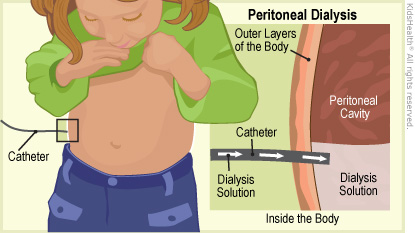Peritoneal Dialysis
What Is Peritoneal Dialysis?
Peritoneal dialysis (pronounced: per-uh-tuh-NEE-ul dye-AL-uh-sis) is a kind of kidney dialysis.
Peritoneal dialysis uses one of the body's natural systems — the lining of the belly — as a filter. Some people like it because it can be done at home. It also can be done during the night so it doesn't interfere with daily life.
Why Do People Need Peritoneal Dialysis?
Our kidneys work like a garbage collection system. They clean extra fluid and waste from our blood. These wastes then leave the body as urine (pee).
If the kidneys stop working properly, waste can build up in the blood. That can get dangerous. So people with kidney failure need to filter out the waste.
How Does Peritoneal Dialysis Work?
The belly has a clear lining called the peritoneum. There are lots of veins and arteries in it, so it's a good place to filter blood. Inside the peritoneum, there's a space called the peritoneal cavity. This space is able to collect and hold fluid and waste so it can be removed from the body.
Before someone starts dialysis, a surgeon puts a tube called a into the person's body near the belly button. This operation happens while the person is asleep under general anesthesia. Doctors usually put the catheter in a couple of weeks before dialysis starts. That gives the area around it a chance to heal.
When it's time for dialysis, the patient (or someone who is helping the patient) puts a cleaning solution called dialysate into the body through the catheter. This is done either by machine or by hanging the solution above the body and relying on gravity to do the rest.

Dialysate uses a type of sugar called dextrose to pull wastes and fluids out of the peritoneum and into the peritoneal cavity. After a set amount of time called the "dwell time," the dialysate, waste products, and extra fluids are drained out of the peritoneal cavity through the catheter. Each cycle of filling and draining the peritoneal cavity is called an exchange.
p
When Is it Done?
Most of the time, people need to do peritoneal dialysis every day.
There are two main types of peritoneal dialysis. Both usually happen at home:
- Automated peritoneal dialysis (APD) is done mostly at night.
- Continuous ambulatory peritoneal dialysis (CAPD) is done mostly during the day.
The decision to do dialysis at night or during the day depends on the person's schedule and what he or she prefers.
Automated Peritoneal Dialysis (APD)
With APD, a machine called a cycler sits by the person's bed. It fills and drains the cleaning solution three to five times during the night. In the morning, the machine fills the peritoneal cavity again, and the solution stays in the body all day. Sometimes, a person might do an extra exchange in the afternoon.
Continuous Ambulatory Peritoneal Dialysis (CAPD)
CAPD is mostly done during the day. The word means the person can walk around and do normal activities while the cleaning solution is in the belly. Someone getting CAPD does about three or four exchanges each day and another one that lasts all night.
CAPD uses gravity to fill the peritoneal cavity with solution and then drain the solution at the end of an exchange. Each treatment uses around 2 quarts of solution — about the same amount of liquid as in a large soda bottle. Filling the abdomen with solution takes 10 minutes or so. The solution stays in for 4 to 6 hours (or through the night) before being drained.
Peritoneal dialysis might not be a good choice for some people. For example, people who are very overweight or who have had surgery in the belly area may do best using another kind of kidney dialysis, called hemodialysis.
Are There Any Risks?
After the surgery to put in a catheter, peritoneal dialysis exchanges are painless.
Peritoneal dialysis does have some risks, though. They include:
- Infection. Germs can get into the body where the catheter goes into the skin and cause an infection.
- Hernia. Holding fluid in the belly for hours at a time can put stress on the stomach muscles and lead to muscle weakness.
p
What Can I Do to Feel Better?
If you're doing peritoneal dialysis, it helps to stay healthy. Taking good care of yourself helps you avoid problems and get the most out of your treatments. Here are a few tips:
- Take medicine as needed. You'll probably need medicines to control your blood pressure, help produce red blood cells, and control nutrient levels in your blood. Follow your doctor's instructions, and talk to your doctor before taking any nonprescription medicines, vitamins, or other supplements.
- Plan ahead. If you'll be traveling, make sure you have everything you need to do your treatments every day. If your doctor or a dietitian puts you on a special diet, find out ahead of time if you can get the foods you need. If not, take them with you.
- Learn what to do. You and other family members will have training to learn how to do peritoneal dialysis exchanges at home. You'll learn how to take care of your catheter and avoid infections or other complications.
Dialysis requires planning. It can be a little inconvenient, but there's no reason for it to slow anybody down.
Looking Ahead
Dialysis is a treatment for kidney disease — it steps in to do the job of the kidneys and keep the body in balance. But it's not a cure. Dialysis alone won't heal a person's failing kidneys.
Sometimes kidney disease will get better and the person won't need dialysis anymore. Other people don't need dialysis because they get a kidney transplant.
People who aren't good candidates for a kidney transplant may need to have dialysis treatments for the rest of their lives. In these cases, people might switch back and forth between peritoneal dialysis and hemodialysis.


